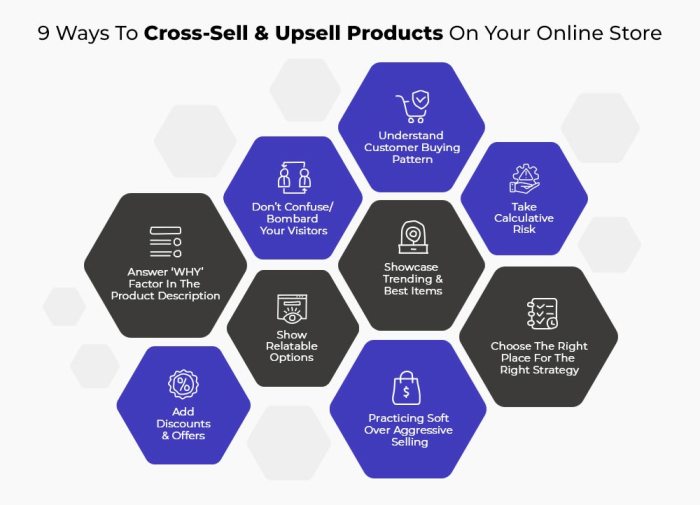Cross-Selling Techniques take center stage in this guide, offering a deep dive into the art of persuading customers and maximizing profits. Get ready for a rollercoaster ride through the world of sales strategies and customer behavior, all with a fresh high school hip style twist.
From understanding customer behavior to implementing effective strategies, this guide will equip you with the tools needed to revolutionize your business approach.
Introduction to Cross-Selling Techniques
Cross-selling is a sales technique where a company sells additional products or services to existing customers. It involves offering complementary or related items to customers who have already made a purchase, with the goal of increasing the value of the sale.
Successful cross-selling strategies often involve understanding the customer’s needs and preferences, identifying relevant products or services that complement their initial purchase, and effectively communicating the benefits of the additional offerings. By recommending products that enhance the customer’s experience or solve a problem, businesses can increase customer satisfaction and loyalty.
Examples of Successful Cross-Selling Strategies
- Amazon’s “Frequently Bought Together” feature that suggests related products to customers based on their purchase history.
- Fast-food chains offering meal deals with add-ons like drinks and desserts to increase the average order value.
- Software companies upselling premium features or add-on services to users who have already purchased the basic version.
The Importance of Cross-Selling in Business Growth
Cross-selling is crucial for business growth as it not only increases revenue per customer but also enhances customer lifetime value. By providing additional value through cross-selling, businesses can strengthen customer relationships, encourage repeat purchases, and drive overall profitability.
Understanding Customer Behavior

In order to effectively implement cross-selling techniques, it is crucial to understand customer behavior and preferences. By analyzing how customers behave, businesses can tailor their strategies to maximize sales opportunities and enhance customer satisfaction.
Segmenting Customers for Effective Cross-Selling
Segmenting customers based on their preferences, buying habits, and demographics can help businesses target the right customers with the right products or services. By dividing customers into different groups, businesses can create personalized offers and recommendations that are more likely to resonate with each segment.
- Segment customers based on their purchase history and frequency.
- Consider demographic factors such as age, gender, and location.
- Utilize data analytics to identify patterns and trends in customer behavior.
- Create targeted marketing campaigns for each customer segment.
The Role of Data Analytics in Understanding Customer Preferences
Data analytics plays a crucial role in understanding customer preferences by providing valuable insights into customer behavior. By analyzing customer data, businesses can identify trends, patterns, and correlations that can help predict future buying behavior and preferences.
Data analytics helps businesses make data-driven decisions and personalize cross-selling strategies for each customer segment.
| Benefits of Data Analytics in Understanding Customer Preferences: |
|---|
| Identifying customer preferences and behavior patterns. |
| Improving customer segmentation for targeted cross-selling. |
| Enhancing customer experience through personalized recommendations. |
Effective Cross-Selling Strategies

Cross-selling is a powerful technique that can help businesses increase their revenue by offering complementary products or services to customers. By implementing effective cross-selling strategies, businesses can not only boost sales but also enhance customer satisfaction and loyalty.
Bundling Products
One popular cross-selling technique is bundling products together. This involves offering related items as a package deal at a discounted price. For example, a tech company could bundle a laptop with a laptop bag and a wireless mouse. This not only increases the value proposition for customers but also encourages them to purchase more than they initially intended.
Personalized Offers, Cross-Selling Techniques
Another effective strategy is creating personalized cross-selling offers based on customer behavior and preferences. By analyzing customer data and purchase history, businesses can tailor their cross-selling recommendations to each individual. This personalized approach can significantly increase the chances of a successful cross-sell as it aligns with the customer’s specific needs and interests.
Upselling Impact
When combined with upselling, cross-selling becomes even more powerful. Upselling involves persuading customers to upgrade to a more premium product or service. By strategically upselling in conjunction with cross-selling, businesses can maximize their revenue potential. For example, a car dealership could offer customers a premium audio system upgrade (upsell) while cross-selling them on an extended warranty package.
Implementing Cross-Selling in Sales Processes: Cross-Selling Techniques
Cross-selling is a crucial strategy in sales that can significantly increase revenue and customer satisfaction. Integrating cross-selling into sales workflows requires a systematic approach to ensure its effectiveness.
Steps to Integrate Cross-Selling into Sales Workflows
- Educate sales teams on the benefits of cross-selling and how it can add value to the customer experience.
- Identify complementary products or services that can be offered to customers during the sales process.
- Train sales representatives on how to identify cross-selling opportunities based on customer needs and preferences.
- Implement a structured approach to cross-selling, such as incorporating it into the sales script or using visual aids to suggest additional products or services.
- Track and measure the success of cross-selling efforts to continually optimize strategies and improve results.
Best Practices for Training Sales Teams on Cross-Selling Techniques
- Provide comprehensive training on product knowledge to ensure sales teams are equipped to recommend complementary offerings.
- Role-play scenarios to practice cross-selling techniques and refine communication skills.
- Incorporate incentives or rewards for successful cross-selling to motivate sales teams and drive performance.
- Encourage collaboration among team members to share best practices and learn from each other’s experiences.
Use of CRM Systems to Enhance Cross-Selling Efforts
- Utilize CRM systems to track customer interactions, preferences, and purchase history to identify cross-selling opportunities.
- Create targeted marketing campaigns based on customer data to promote cross-selling initiatives effectively.
- Automate cross-selling recommendations within the CRM system to streamline the sales process and increase efficiency.
- Analyze data from CRM systems to measure the impact of cross-selling efforts and make data-driven decisions for future strategies.





